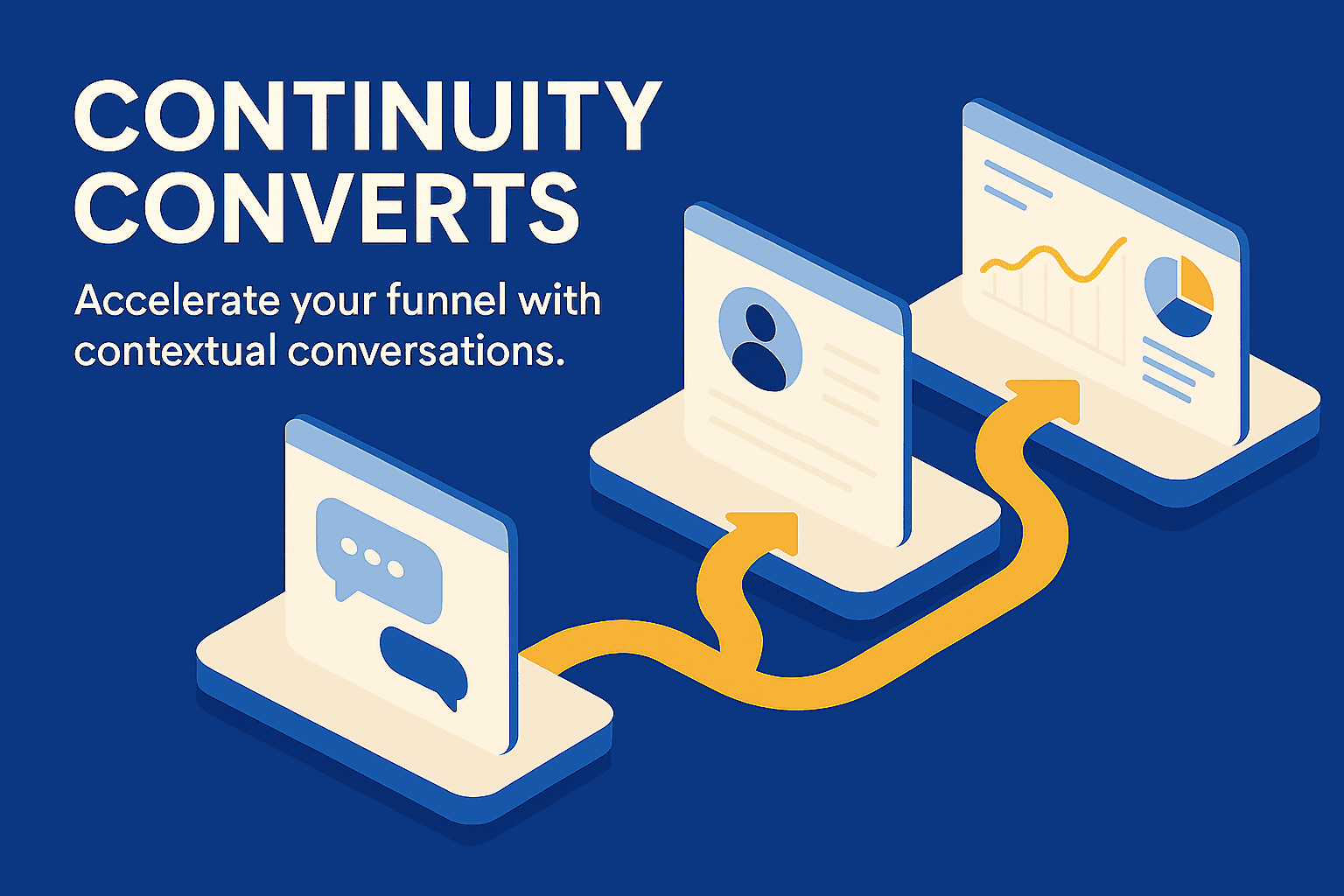The Lead Conversion Problem And How A Conversation Graph Solves It

“Fifty percent of buyer intent cools within sixty minutes.”
Customers jump channels without warning. Tap a reel. Skim pricing. Ask a question. Call for details. Silence. Expectations are simple and strict. Fast replies. Relevant replies. Should the next touch remember the last one? Absolutely.
Current systems handle pieces well. CRMs store fields. Email platforms send at scale. Ad tools watch clicks. But the handoffs? That is where things slip. Conversations do not travel. Context drops between Instagram, SMS, email, calls, and forms. Minutes pass. Meaning fades.
The cost is real. Urgency drains. Generic follow-ups land. Response times stretch. Leads stall, acquisition spend climbs, and conversion falls. Revenue leaks in tiny delays measured in minutes!
A better way looks like this:
a Conversation Graph that keeps one living profile per person, built from every message, emotion, and action. A single customer view that unifies identifiers, intent, sentiment, and recency. Agentic AI uses that profile to choose the next best move in the moment, on the channel that makes sense. Speed plus memory wins!
The Lead Conversion Problem: Conversations Without Continuity
Think about the last time someone interacted with your business. For example, in a gym context:
- They saw an Instagram reel of your new spin class.
- Later, they sent a direct message to ask about trial sessions.
- The next morning, they checked pricing on your website.
- In the afternoon, they called to ask if you have weekend slots.
- That evening, they received an automated email offering a seven-day pass.
In most lead stacks, each of these touchpoints lands in a different silo. Social messages live in a brand inbox, call recordings sit in a support system, emails live in a marketing platform, and website visits sit in analytics. None of them talks to each other.
The result is disconnected experiences. The prospect who just asked about trial slots still gets a generic Join Now campaign. The person who called about weekend timings gets retargeted with weekday only offers. A member who complained about billing receives an upsell nudge the same evening.
Across industries, this is not a small issue. Many customers switch brands after a single bad digital experience. In lead-driven sectors where retention drives profitability, every broken interaction is revenue left on the table.
Conversation Graph
A Conversation Graph is a unified, real-time ledger of everything a customer says, does, and feels while interacting with your business. Instead of scattering interactions across platforms, it connects them into one living narrative.
At its core, the Conversation Graph powers a single customer view. All signals roll up into a unified customer profile that combines identifiers, intent, sentiment, preferences, and recent activity. That profile updates in real time and is available to every channel and agent.
Think of it as a brain for your marketing and sales stack. Every node on the graph could represent:
- A text inquiry about weight loss programs
- The tone of voice in a call where someone sounded hesitant about pricing
- A click on your trainer bios page
- A direct message asking if you offer Zumba on weekends
- The fact that they did not respond to your last follow-up email
Unlike traditional CRMs, which only log structured fields like Lead Source equals Instagram or Status equals Hot, a Conversation Graph captures intent, sentiment, and context in real time.
This means your marketing is no longer guessing. It responds intelligently based on the full story.
Why Lead-Driven Businesses Need It
1. Timing is Everything
Decisions around high consideration purchases are emotional and perishable. Someone browsing membership plans at ten p.m. on a Sunday is motivated right now. If you wait until Monday morning to respond, a competitor may win the deal. The same holds for a mortgage pre-approval started at night, a test drive request placed after hours, or a demo form submitted during a webinar.
A Conversation Graph ensures that when intent spikes, for example, a trial pass download, a repeat visit to pricing, or a message inquiry, an AI agent can instantly trigger the right action. That can be a timely message, a personalized offer, or a human callback. This is agentic AI journey orchestration in practice, where autonomous agents choose the next best step based on the unified customer profile.
2. Journeys Are Multi-Channel
Your prospects do not live in one channel. They mix social messages, SMS, email, calls, ads, and in-person visits. A rate quote might start on a mobile site and finish on a call. A test drive can be booked from a chat link. A demo can move from chatbot to calendar without losing context. Without a unified memory, each channel acts blindly.
With a Conversation Graph, context travels with the person, so a reply on SMS remembers the question they asked on Instagram.
3. Unstructured Data Holds the Truth
A buyer decision to move forward often is not in structured fields like the last visit date. It is in unstructured cues:
- The frustration about billing in a support call transcript.
- The hesitation in a text message that says Thinking about pausing for a while.
- The excitement in a direct message that asks Do you also have morning options.
Across sectors, similar cues appear: a mortgage shopper asking about rate lock timing, a car buyer texting need to think after a test drive, a buyer replying when is the earliest onboarding call.
Traditional tools ignore most unstructured data. A Conversation Graph treats it as first-class input, ensuring your marketing responds to human signals, not just clicks.
4. Retention is the Profit Engine
Acquiring a new customer is expensive relative to retaining an existing one. A Conversation Graph helps identify early churn signals, such as missed appointments, negative sentiment in chats, or declining engagement, and then triggers retention actions in real time.
How a Conversation Graph Transforms Lead Conversion
Lead generation
Instead of running broad Join Now ads, target based on live signals. For example: Show ads to people who mentioned weight loss or summer body in chat in the last seven days. The same pattern applies elsewhere: mortgages combine recent rate page visits with pre-approval starts, auto pairs model page revisits with test drive requests, and SaaS looks at pricing page revisits plus demo replies.
Conversion
When a lead asks about pricing on SMS, the agent sees they also attended a trial class last week and tailors the offer
In lending, an SMS pricing question plus a recent rate page revisit can trigger a tailored offer on rate lock options.
In automotive, a model comparison plus a test drive request can route straight to a callback with available slots.
In SaaS, a pricing reply after a product tour can prompt a short plan comparison with a calendar link.

Onboarding
A new customer downloads your app, books two high-intensity sessions, and ignores yoga. The Conversation Graph and agentic AI nudges them with:
Want to try your first yoga class for free this weekend?
In SaaS onboarding, a user who set up SSO but skipped usage tips gets a five minute quick start. In education, an applicant who booked a campus tour but skipped the scholarship page gets a short guide to aid options.
Retention
If sentiment drops in support chats, for example, Locker rooms are too crowded, the system suppresses upsell campaigns until the issue is resolved, avoiding tone deaf outreach.
In insurance, a claims frustration suppresses cross-sell pitches until a resolution update is sent. In wellness, repeated no-shows trigger a gentle schedule reset offer. In B2B, a stalled proof of concept prompts a weekly value recap instead of another generic check-in.
Cross-sell and upsell
Leads who show interest in personal training via a direct message get automatically prioritized for a trainer callback, with full context of prior questions.
Why Legacy Systems Cannot Do This
Legacy CRMs and marketing tools were built for structured data, forms, clicks, and checkboxes. They were not designed to store hesitant tone in a text chat or to be frustrated about billing on a call.
Even when businesses bolt on AI features such as chatbots, lead scores, or automated emails, they still operate in silos. They lack a true single customer view and cannot coordinate agentic AI journey orchestration end to end. That is mechanical personalization rather than intelligent orchestration.
Here is how it plays out in real life.
A prospect clicks an ad, skims the site, asks a question in chat, and later replies by SMS. The form lands in the CRM. The chat sits in a help tool. The SMS lives in a shared phone. A new agent calls without the thread. Questions get repeated. Minutes pass. Confidence drops. The prospect goes quiet.
The Conversation Graph changes the architecture. It treats every conversation as the workflow, the trigger, and the data. Instead of three tools fighting to stitch together the journey, one system remembers, reasons, and responds.
Practical Steps for Lead-Driven Businesses
1. Start With a Data Foundation
Unify all lead and customer records into one profile. This becomes your single customer view. Connect CRM, SMS, social messages, website, call logs, ads, and email. For example, pair Meta and WhatsApp for wellness consults, your loan origination system for lending, your dealership CRM for auto, and your marketing automation and product analytics for SaaS.
2. Integrate Into the Conversation Graph
Feed structured and unstructured data into one timeline. Every chat, call, click, and campaign touch becomes queryable.
3. Deploy Starter Agents
Use agentic AI micro agents for specific pain points first, for example responding to trial pass inquiries within two minutes, or nudging members who missed two classes in a row. These agents orchestrate the journey step by step across channels. Examples include answering premium questions for insurance, scheduling test drives in automotive, routing high intent pricing chats to account executives in SaaS, and booking consults in wellness.
4. Add Retention Triggers
Configure agents to detect churn signals, negative sentiment, drops in attendance or engagement, and trigger proactive outreach. In lending, watch for incomplete pre-approvals. In auto, missed service reminders. In SaaS, there is a decline in weekly active users. In insurance, repeated quote requests without a bind.
5. Build Feedback Loops
Measure what works. Which offers convert trials.
Which sequences save at-risk customers? Refine continuously.
The Competitive Advantage
Most lead-driven markets offer similar products, services, and price points. What sets you apart is the experience.
When a prospect feels like your business gets them, answers fast, remembers their needs, and nudges them at the right moment, they are far more likely to convert and stay.
A Conversation Graph gives you this edge:
- Faster lead conversion
- Higher retention
- Smarter ad spend
- A unified brand voice across channels
- A reliable single customer view that every team can use
Final Word
You do not just sell products or services. You sell trust, motivation, and belonging. That means every conversation matters, from the first inquiry to the one hundredth renewal. But conversations lose their power when they live in silos.

The Conversation Graph turns those scattered signals into a living narrative your business can act on, instantly, intelligently, and at scale.
In markets where switching is a single click, that narrative may be the difference between being just another vendor and becoming the trusted choice.
Zigment is an agentic AI platform that creates your Conversation Graph and single customer view across channels. It turns scattered interactions into one living profile that every team can use.
How Zigment solves it
- Connects CRM, SMS, WhatsApp, email, web chat, telephony, ads, and analytics into one timeline
- Detects high intent signals and sentiment in real time
- Orchestrates next best actions with autonomous micro agents across channels
- Personalizes replies with memory of the last touch
- Tracks the metrics that matter: time from signal to meaningful reply, conversion rate, retention
